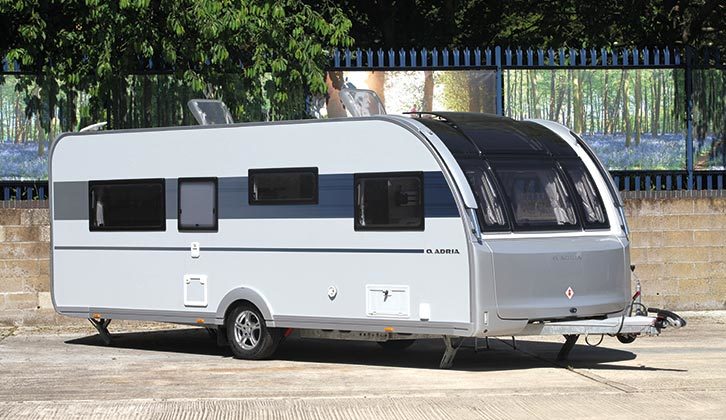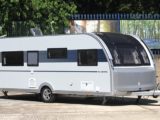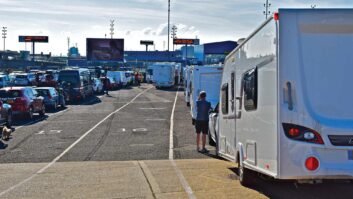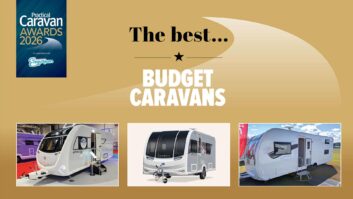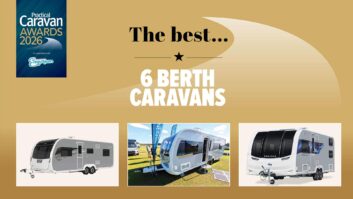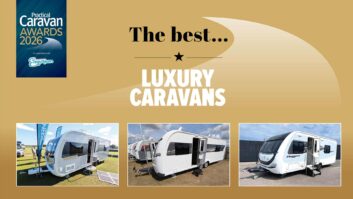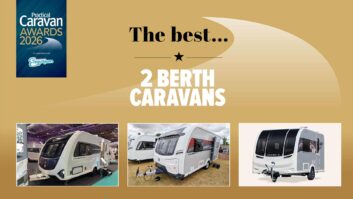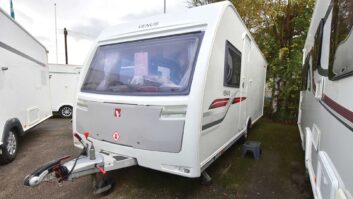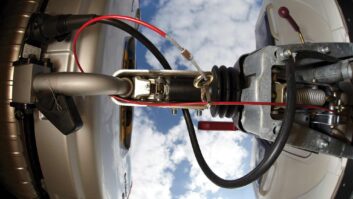Tourers come in all shapes and sizes, which can make selecting the right one for your needs a bit daunting. That’s where having an understanding of the different types of caravan comes in.
You have to balance the pros and cons of each option against what you and your family require. Compromises have to be made to find the best caravan for you – space and facilities are good, but length and weight are generally considered bad. Twin-axles are great to tow, but fitting a super-sized caravan onto your driveway at home could be problematic.
Here, Practical Caravan takes a look at the advantages and disadvantages of each type of caravan – you can also take a look at our best caravan manufacturer guide to find out more about the makes out there.
Or maybe you’re not quite settled on whether you want a tourer or a ‘van? In which case, our caravan or motorhome guide is sure to help.
The different types of caravan
Teardrop caravans
Teardrop trailers like the Vagabond Rogue are tiny, which makes them perfect for storing and towing, but in terms of comfort and versatility, some will find them limited. Put simply, they are a covered bed on wheels, with more upmarket ones featuring a compact kitchen and possibly even a handbasin.
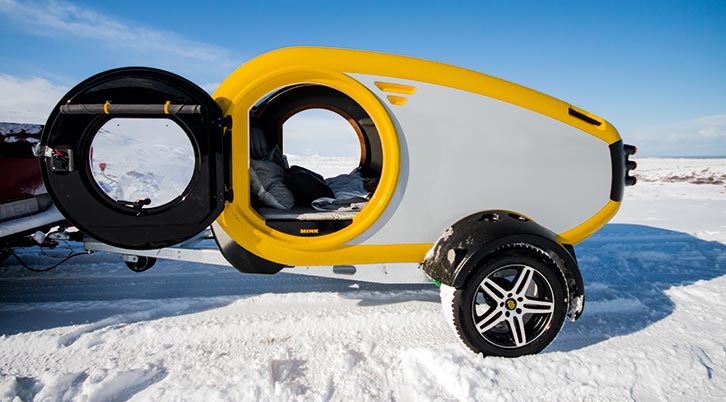
The average teardrop provides a small doorway, which opens to reveal a large, wall-to-wall double bed, a window, an air vent and perhaps a little storage space… but not that much more.
You won’t be able to stand up inside a teardrop, but you can tow it with a Mini or a Cinquecento – and you’ll definitely attract admiring/bemused looks.
For daytime living, you will really need an awning or a gazebo (unless you want to spend all day in bed). But for many, that enhanced outdoor living is all part of the teardrop’s appeal.
Step out of the trailer and go around to the sloping back and you’ll often find a cleverly concealed selection of facilities. This might include a camping-style stove, some storage, and even a basin and food prep space.
Basically, tiny teardrops are for the more robust caravanning types, who appreciate sleeping under cover in a solid structure, but don’t need all of their home comforts when they tour.
Another point to bear in mind is that as caravan prices rise, these brilliantly packaged mini-tourers often offer good value. We particularly like the futuristic Mink, which combines comfort and towing practicality with super-cool space age looks that should seduce even the most fervent anti-caravanner.
Mink’s robust design makes it a true ‘go-anywhere’ camper. Its porthole door opens to reveal a queen-sized double bed, a child’s bunk and optional heating, all in a very cosy interior. A full kitchen facility is accessible at the rear. You can read our 2021 review of the Mink 2.0 Sports Camper to find out more.
Pop-top and folding caravans
Pop-top and folding tourers are superb examples of compact engineering, with arguably the best examples coming from Eriba, Silver and Gobur.
These vans generally have quite compact proportions, so can be garaged at home, and some fit under car park height barriers.
Pop-top caravans
With pop-tops, a section of the hard roof rises (either manually or electrically) to increase the headroom inside. The sides of the extension are generally fabric.
The classic Eriba pop-top is recognised as a design icon, with its retro looks and robust German build quality.
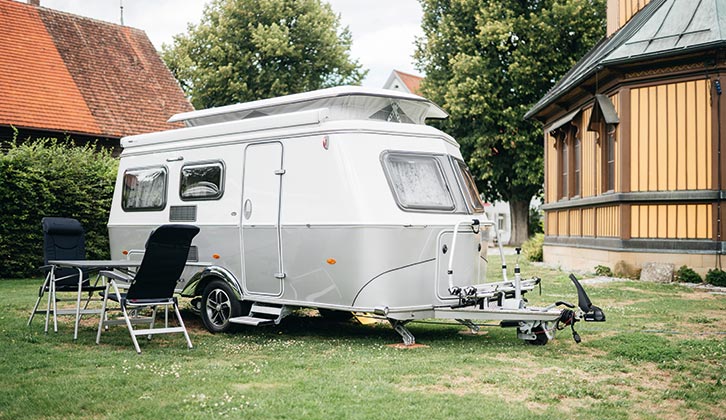
Inside, the facilities are cleverly packaged to offer everything you need, but in bijou proportions. With the top popped, those over six foot can stand tall for cooking and washing, but there’s no getting away from the fact that life in these timeless tourers does require some adjustment, and your storage needs to be very organised.
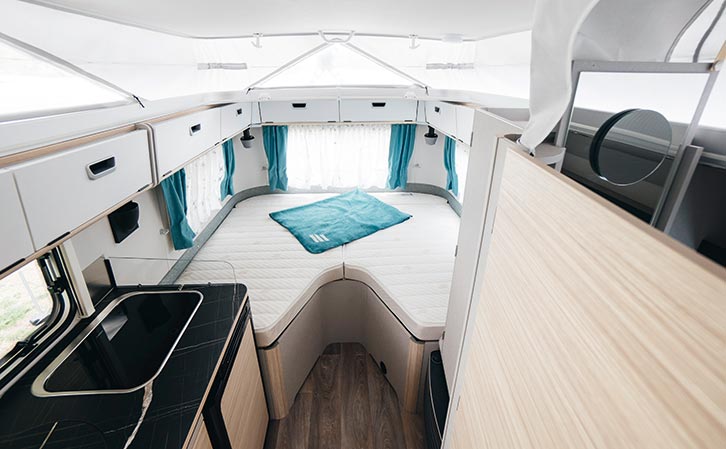
I especially love the four-berth Eriba Touring, and while the prices start from £22,000, a well-kept example of this quality German van will really hold its value.
The Silver Mini Freestyle caravan from French giant Trigano may not have the immediate visual appeal of its German competitor, but it does offer buyers some real home-from-home comfort in a neat and convenient package.
The single-axle Freestyle has an MTPLM of 1000kg (so it’s easy to tow with a wide range of cars), but a huge 312kg payload, and prices start at under £17,000.
Inside this two-berth, the caravan layout is much more recognisable to those who have been in contemporary caravans, and it makes excellent use of the available space. I would say it feels more spacious than the Eriba.
Folding caravans
Meanwhile, folding caravans start out as low-profile trailers, but have solid panels that will quickly slide and lock into position to make them full-height.
Gobur is perhaps the best-known folding-caravan manufacturer. Its products have solid panels and start off as waist-high trailers, which can be quickly and easily converted into caravans of 2m-plus height when you arrive on site.
This is good for both storage, and fuel consumption when you’re towing.
These days, Gobur only sells pre-owned models, but you can find them in three flavours: Slimline, Standard and Clubman. Something for every taste!
Trailer tent
I’ve included this type of caravan because I believe the Opus Air bridges the gap between camping and caravanning quite brilliantly.
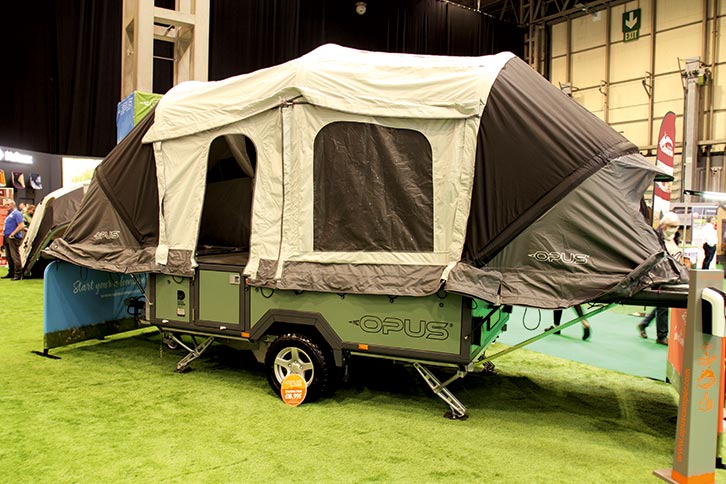
Starting off as a waist-high, slimline trailer, Opus expands in a few minutes to create a huge and spacious ‘mobile home’, with two double bedrooms and a sizeable lounge/kitchen. The expansion is done electrically, as a pump inflates the robust airbeams, which haul the technical-fabric roof and sides into shape.
In towing mode, the Opus trailer can be loaded with bikes, surfboards or canoes for the full action-man (or woman) effect!
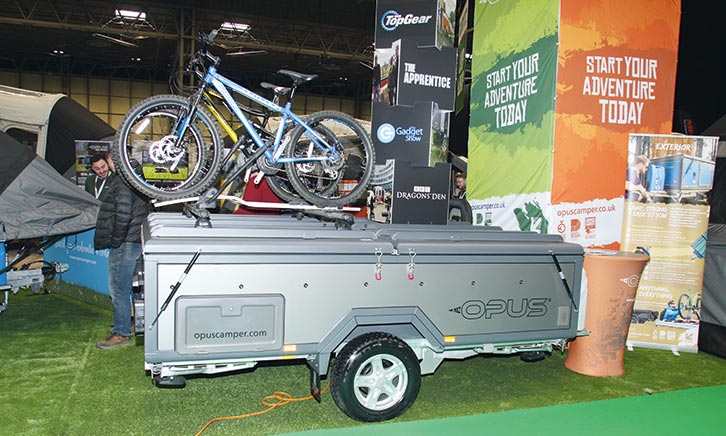
Compact Adventure Caravans
Sales in this sector have grown massively in recent years, as exciting new compact tourers have entered the market. Branding these as ‘adventure caravans’ appears to have attracted many who didn’t previously see themselves as ‘white box’ caravanners.
Two of my favourite vans inhabit this sector: Knaus’s Sport&Fun and Swift’s Basecamp 2. Both combine diminutive proportions with trendy styling and the ability to transport lots of outdoor leisure accessories, from mountain bikes to canoes.
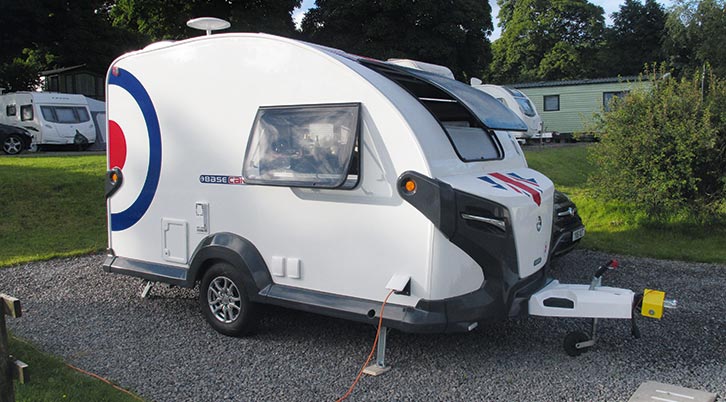
These vans are full-height and width, but relatively short in length, with doors on the back (the Knaus has a side door, too).
The wide doors make it easier to load your kit (take a look at our how to load a caravan guide for more on this). In the Basecamp, the two side sofas fold up and clip in place, providing a good width of uninterrupted floor space to load equipment. The floor also features integral anchor rings for securely tying down bikes and the like.
Basecamp comes with a roof-mounted 100W solar panel to keep the leisure battery topped up, while a vast, bespoke Vango end-awning is an optional extra.
Both adventure vans have full washrooms with shower and toilet, efficient heating and lighting, and good cooking facilities.
Sport&Fun takes a different approach, with an unusual internal layout. A large double bed at the front end is raised up, allowing extra space in a massive ‘garage’ underneath. This area can be accessed via a substantial side-hatch, or by raising the spring-loaded bed base.
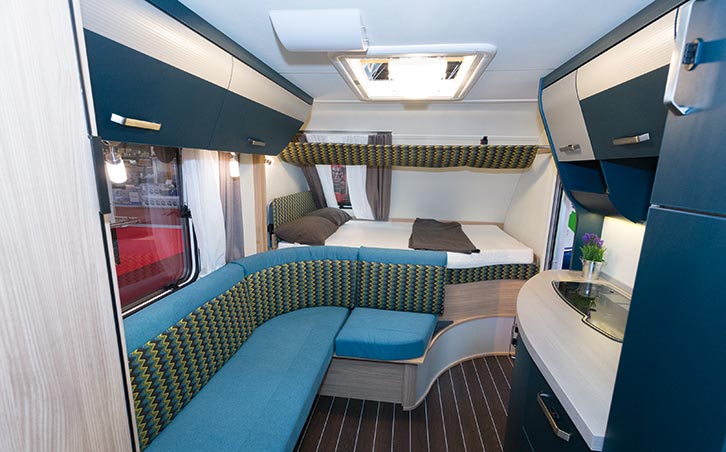
A ladder fixed to the rear allows for easy roof access, where a roof box or other storage could be fitted to the roof rails. Take a look at our review of the 2023 Knaus Sport&Fun Black Selection for more information.
Small caravans
Almost all manufacturers offer compact two-berth options, ideal for caravanning couples. These types of caravan look similar to, and offer many of the facilities of, their bigger siblings, but with some elements condensed.
One of our favourites – and an Award Winner at the Practical Caravan Awards 2022 – is the Swift Conqueror 480. This amazing single-axle gem has a front-lounge and rear-washroom layout, with a kitchen in between. In day mode, you can relax in the generous living space, while at night, this converts into a 6ft 1in x 6ft 7in bed.
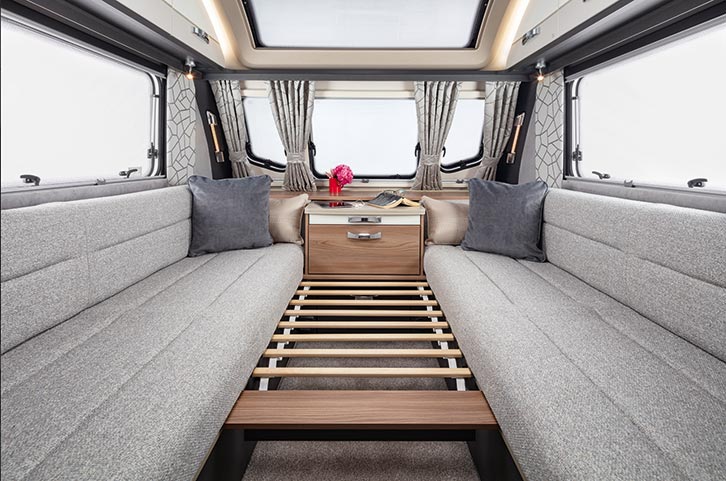
Despite their diminutive size, these two-berths are often packed with facilities, including a hob, oven and microwave, full heating systems and lots of storage.
Because the settees transform into a double bed, you do have that chore each evening; there’s no room to squeeze in a fixed bed. Mind you, in warmer climes, we’ve left the bed made up and relaxed outside.
Another great two-berth option is the Freedom Jetstream. This Polish-built tourer features time-proven GRP construction methods, creating enduring caravans that pack a lot into their tiny dimensions.
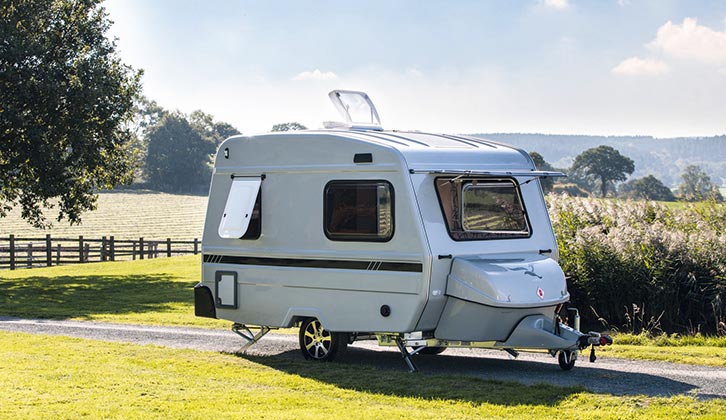
The Freedom Jetstream Twin-Sport weighs just 750kg, although this can be upgraded to 850kg, allowing for a more useful 150kg payload. Internal headroom is just 6ft, which some might find limiting.
Inside, you’ll find a full shower and toilet, compact kitchen and lounge/bedroom. The U-shaped seating converts into a double bed, while the kitchen boasts a 60-litre fridge, a sizeable sink and a combined oven/grill, next to a two-burner gas hob. The unusual storage locker mounted on the A-frame stores the spare wheel and gas bottle.
You can take a look at our best small caravan round-up for more ideas and inspiration.
Family caravans
Four-berth family caravans are the most common tourers on Britain’s campsites (see our guide to the best caravan parks if you want some help choosing your next touring destination), so accordingly, there’s a huge range of styles and layouts to choose from.
In fact, many couples prefer the extra space in a four-berth tourer and may only use the additional beds occasionally, when they have guests visiting.
In these caravans, you will usually get a generously proportioned lounge/dining area. The daytime seating converts into a double bed at night.
Some couples prefer the convenience of a fixed bed at the rear of the caravan, which is permanently made up; but if you don’t mind making your bed each night in the lounge, this can free up space for a larger washroom or a dining area.
Beds are indeed the most important factor affecting your choice of four-berth caravans. As well as the make-up option in the lounge, you can have a permanent bed in various forms: French style (where one occupant sleeps against a wall) or an island bed (where you can access three sides of the bed).
The latter can be positioned transversely across the van or centrally on the rear wall, in a mid-washroom tourer (these beds tend to be a bit shorter).
Depending on spec and layout, these vans offer an MTPLM of 1200-1700kg, so are towable by a wide range of cars – you don’t have to drive a thirsty SUV.
The typical four-berth is so popular because it is such a versatile space, offering comfort and convenience for a broad spectrum of caravanning needs.
Our favourite this year is the Adria Adora Tiber (MTPLM 1800-1900kg, depending on chassis option), with its spacious U-shaped lounge seating and compact fold-down table, big kitchen, central washroom and toilet, and rear bedroom with the central bed coming off the rear wall. This bed is full-sized and isn’t limited by a bulkhead wall.
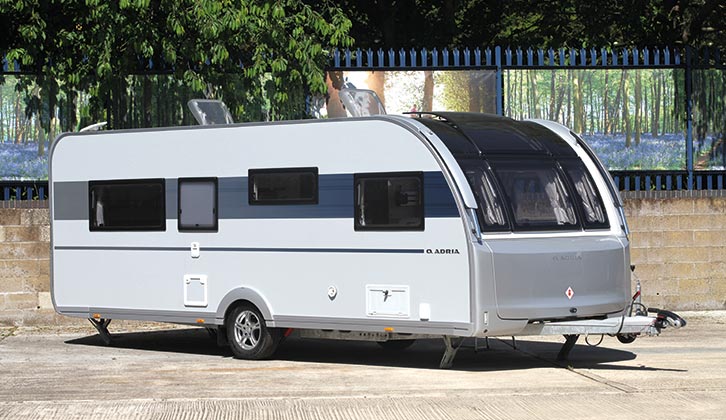
Another great option is the Bailey Discovery D4-D. This is a less costly option, but equally packed with enticing goodies. As well as a comfortable lounge and well-appointed, compact kitchen, the D4-D has a French bed at the rear, with a cut-off corner.
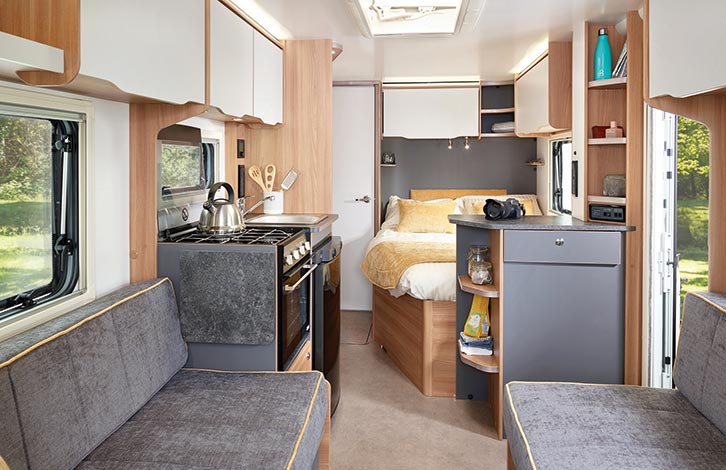
Behind the bed is a spacious washroom with toilet, basin, shower and storage.
As well as costing less than the Adria, this neat Bailey is far lighter, with an MTPLM of just 1206kg – so supremely towable with most standard family cars.
Large caravans
The biggest caravans tend to serve one of two purposes: most often they are for larger families with four or more children, but sometimes, the vast amount of extra space and (usually) luxury they offer appeals to couples and smaller families, especially those who like to take longer breaks or perhaps pitch seasonally.
You really are choosing extra space with these tourers and they are huge, but that does mean you often need a large tow car, such as a big SUV, a pick-up, or even a van like the VW Combi.
Towing and manoeuvring these beasts is simple enough, with the right vehicle and training. We recommend taking a towing course before you head out on the road.
Inside, these vans have up to six berths (always with a large make-up or permanent double bed), roomy lounges in a range of layouts, generous kitchens and spacious washrooms. Pop on a full awning and you have a huge, versatile space (somewhere to exile the children when they fall out!)
Many of these vans are twin-axles, which offer better towing manners, but this does increase the long-term ownership costs, for tyres, fuel, pricier services and so on.
A heavier, more traditional six-berth is the 8ft-wide Avanté 868 from Elddis. This 1724kg MTPLM tourer rolls on twin axles and offers loads of space. The fixed double bed at the rear is by bunks for the younger kids, so parents can keep an eye on them. The facilities sit in the middle, while the front lounge area is spacious and very comfortable.
Lifestyle caravans
There’s a type of caravan for virtually every lifestyle, from budget weekends away with the kids, to hardcore outdoor pursuits or fun at a music festival.
Two such ‘lifestyle’ caravans – one a global icon and the other super-cute – are Airstream and Barefoot.
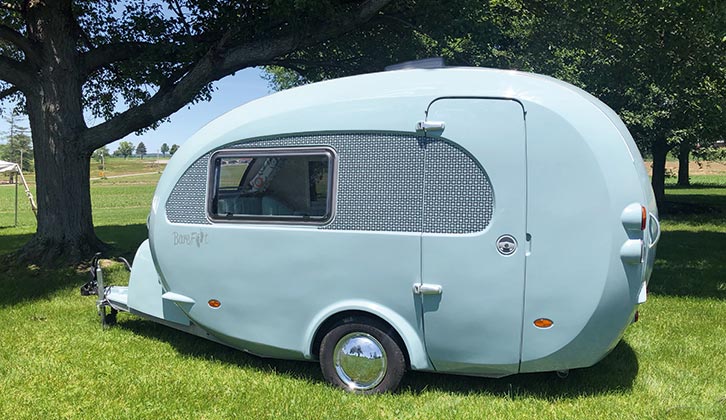
Polished-aluminium Airstreams are crafted in the US and then adapted for UK conditions. They come in various sizes and specs, but all have the legendary curved, metal exterior
and stunning contemporary furniture and fittings inside.
Nothing says “I’ve arrived!” quite like an Airstream, and while they are quite pricey, well-maintained models do hold their value well. I once towed one to Yorkshire for a festival, and I swear chiropractic revenues on the route must have spiked as every passer-by craned their neck to take in its lines!
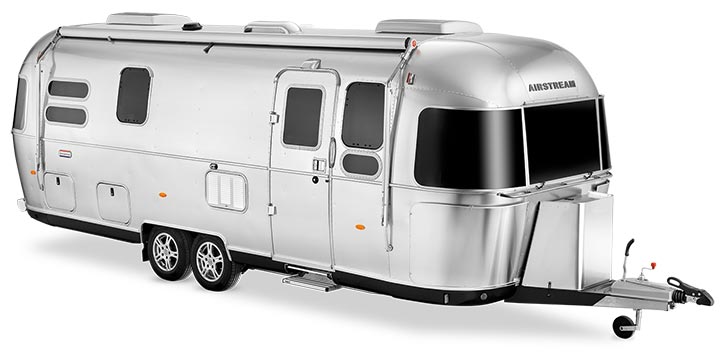
At the other end of the spectrum, size-wise, is the Barefoot. These chic little pastel-hued ‘eggs’ are manufactured in a single, seamless piece of GRP, eliminating the chance of water ingress and creating a robust and rigid shell. As well as being aerodynamic, there’s an eye-watering amount of comfort crammed inside. You’ll have hygge-overload from expertly stitched sofas, solid wood worktops and other clever design touches. They also squeeze in a full shower room and toilet.
Many owners personalise their Barefoot with graphics and other additions, as if they don’t already look supremely cool…
If you enjoyed finding out about the different types of caravan, why not take a look at these:
- We talk you through the process of hitching up a caravan
- We explain everything you need to know about the CRiS Registration scheme
If you’ve enjoyed reading this article, why not get the latest news, reviews and features delivered direct to your door or inbox every month. Take advantage of our brilliant Practical Caravan magazine SUBSCRIBERS’ OFFER and SIGN UP TO OUR NEWSLETTER for regular weekly updates on all things caravan related.
